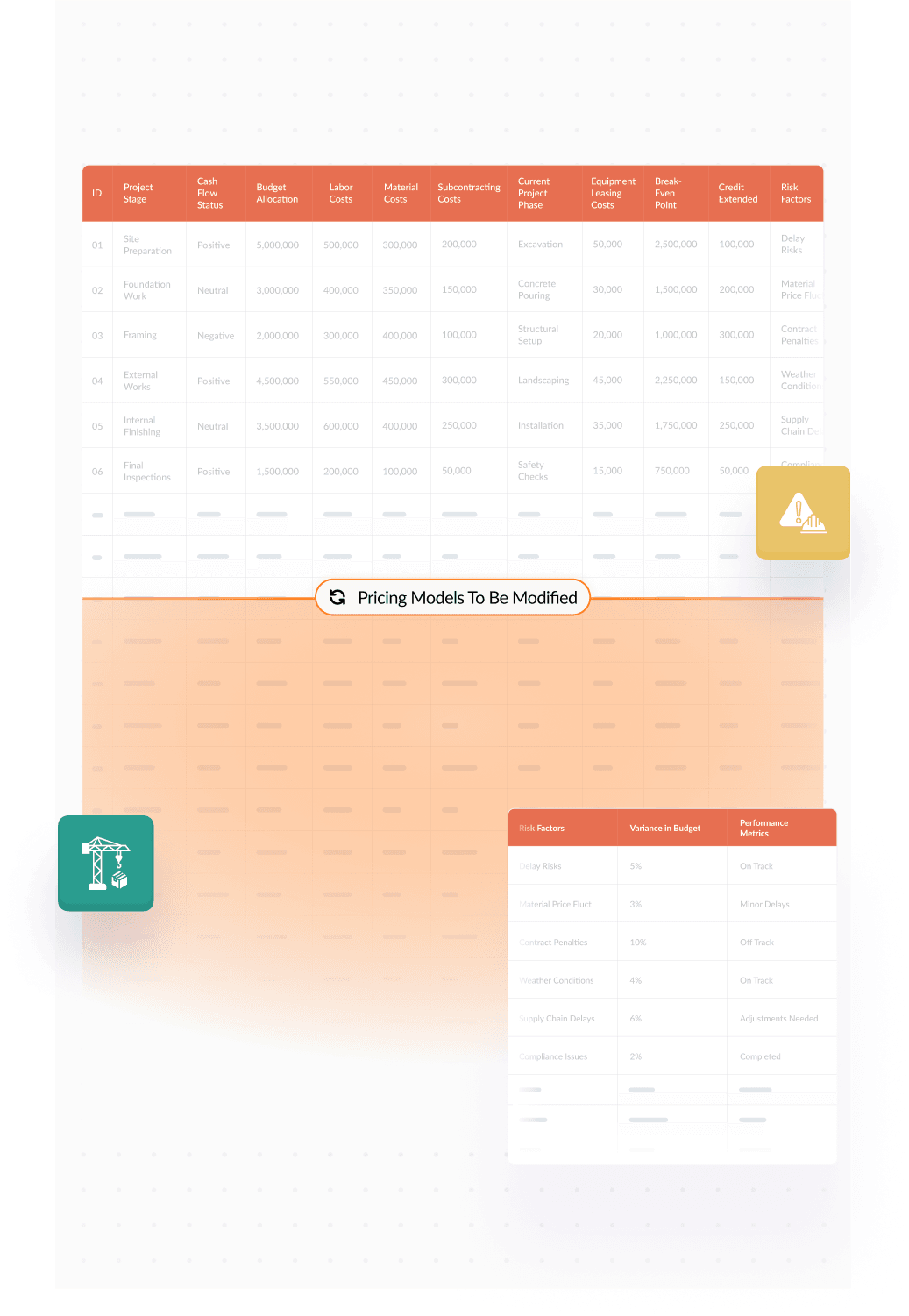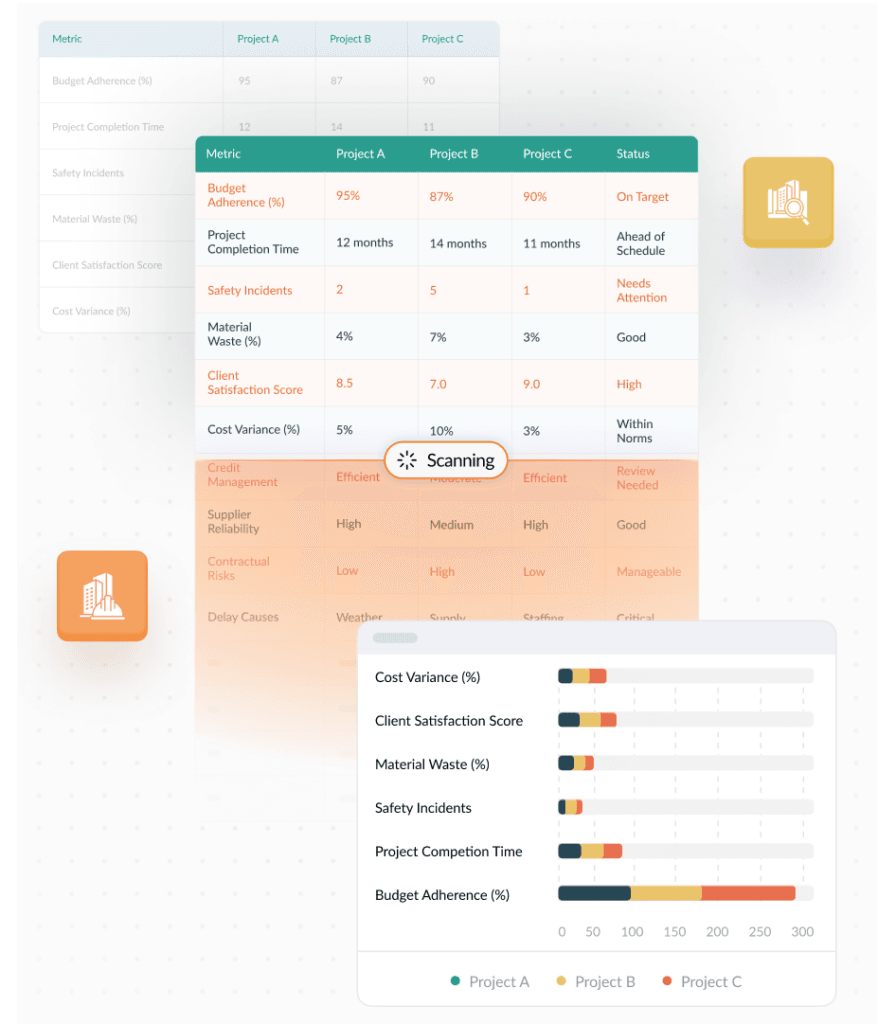Construction

Financial & Capital Analytics
Project Cash Flow Management: Critical analysis of cash flows specific to construction projects to manage phased disbursements and revenue receipts, vital for maintaining liquidity without external financing pressures
Cost Monitoring and Control: Implement granular tracking systems for project-specific expenditures, including direct labor, materials, and subcontracting costs, with alerts for budget deviations
Asset Lifecycle Analysis: Evaluate the cost-effectiveness of construction equipment ownership versus leasing options, including detailed depreciation schedules and break-even analysis
Project Funding Structures: Develop tailored financing solutions for projects, blending short-term construction loans with long-term financing options to match project cash flow profiles
Project Bid Financials: Craft competitive and profitable project bids based on comprehensive cost and margin analysis, considering current market conditions and competitor bidding trends
Economic Impact Assessments: Conduct financial assessments of macroeconomic and sector-specific trends such as changes in commodity prices or labor rates on project costs and timelines
Project Profitability Modeling: Create detailed financial models that forecast project profitability under various scenarios, incorporating risk factors such as project delays or cost overruns
Break-even Analysis: Detailed calculation to determine the break-even points for various types of construction projects, considering fixed and variable cost structures
Contractual Risk Evaluation: Analyze and mitigate financial risks from contract terms, focusing on penalties for delays, dynamic material pricing clauses, and scope creep
Credit Management: Strategies to manage credit extended to clients, including staged payments linked to project milestones and rigorous client credit assessments
Real-Time Performance Tracking: Deploy real-time dashboards to monitor financial performance against budgets at the project and organizational levels
Variance Investigation: In-depth analysis of variances from planned financial outcomes, providing actionable insights into cost control and resource allocation
Strategic Acquisitions: Financial due diligence for potential acquisitions, focusing on integration of acquired entities to leverage synergies in procurement, project management, and client base expansion
Joint Venture Evaluations: Financial modeling and scenario analysis for joint ventures, particularly for large-scale projects or entry into new geographic markets.
Process Mining
Extract data from project management tools, time tracking systems, and supply chain logs, which document every aspect of a construction project
Organize the collected data chronologically and by project component, ensuring that the timeline of logs matches the project schedules
Generate a process model that reflects the actual progression of construction projects, showing the sequence of activities from site preparation through to the final inspection
Check the real project execution against the planned architecture and engineering designs and identify deviations in timing, budget overruns, or non-compliance with safety standards
Improve scheduling accuracy, resource allocation, and compliance with safety protocols and adjust project management approaches based on the data-driven insights to prevent future overruns and delays


Business Intelligence
Analyze past project data to summarize timelines, budget adherence, and the frequency of safety incidents to provide a baseline measure of project management effectiveness
Investigate causes of delays and budget overruns in specific construction projects by examining project logs, weather reports, and supply chain issues
Forecast potential project delays using historical data on weather patterns, supplier reliability, and previous project outcomes to better plan and manage future projects
Use insights from predictive analytics to adjust project timelines, workforce allocations, or materials sourcing strategies to mitigate risks and enhance efficiency
Combine data from project management software, worker feedback, and completion reports to infer best practices for safety and efficiency, setting the stage for more informed decisions in future projects
Streamlining
Map out all phases of construction projects, from initial bidding to final inspections. Identify inefficiencies like duplicated job roles, unnecessary approval stages, or logistical delays in supply chain management
Implement project management software to automate task scheduling, budget tracking, and communication among stakeholders. Use CAD and BIM software for efficient design and planning
Monitor key metrics such as project completion times, budget adherence, safety incidents, and material waste percentages to gauge project efficiency and areas for improvement
Combine multiple subcontractor roles where possible or centralize purchasing for materials to gain bulk buy discounts and reduce management layers
Standardize building processes, materials, and designs where feasible to reduce variability, speed up construction, and ensure quality control across projects
Gather feedback from project managers, subcontractors, and clients throughout the construction process to identify areas for improvement and increase stakeholder satisfaction
Review comxpleted projects to assess if the streamlining efforts have met cost-effectiveness and timeline goals. Use lessons learned for continuous improvement in future projects

